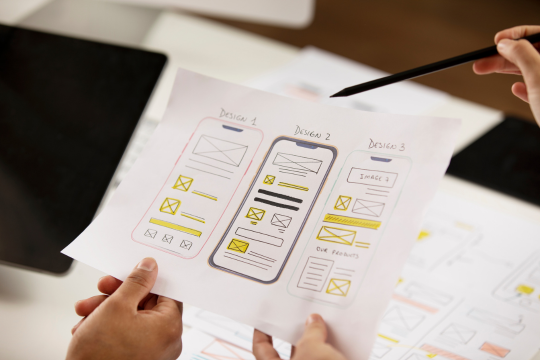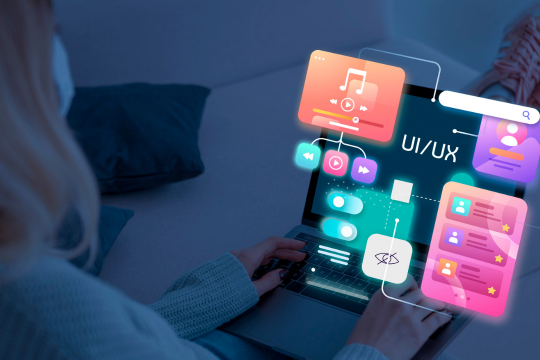The Future of Web & Mobile Design: Trends You Need to Know
In the fast-changing digital world today, web and mobile designis transforming on an enormous scale. What was effective a year ago might already be obsolete in the present. With changing technology and user behavior, it is important for designers, developers, and companies to remain ahead of the game. This blog discusses the major trends governing the future of web and mobile design, shared in a comprehensive, point-by-point manner.
Table of contents [Show]
- 1 Discover the Future of Web and Mobile Design
- 1. 1 1. Emergence of AI-Driven Design Tools
- 1. 2 2. Theme Customization and Dark Mode
- 1. 3 3. Voice User Interface (VUI) Integration
- 1. 4 4. Microinteractions and Motion UI
- 1. 5 5. Minimalist and Content-First Layouts
- 1. 6 6. Immersive Experiences: AR and VR
- 1. 7 7. Mobile-First to Mobile-Only Design
- 1. 8 8. Accessibility-First Design
- 1. 9 9. Sustainability in Design
- 1. 10 10. Neumorphism and Glassmorphism UI
- 1. 11 11. Real-Time Collaboration Features
- 1. 12 12. Advanced Personalization Through Data
- 1. 13 13. Cybersecurity-Focused UI Design
- 1. 14 14. Scrollytelling and Visual Narratives
- 1. 15 15. No-Code & Low-Code Design Tools
- 1. 16 Conclusion: The Future is Fluid
Discover the Future of Web and Mobile Design
Leap ahead in the digital age by uncovering the newest trends transforming web and mobile design's future. From AI-powered tools and immersive experiences to mobile-first and accessibility-first strategies, this guide plunges into the breakthroughs changing the game of user experience. Discover how revolutionary design methods such as dark mode, voice UI, microinteractions, and no-code platforms are leading the way for contemporary websites and mobile applications. Regardless of whether you are a designer, developer, or entrepreneur, awareness of these trends is vital to designing responsive, interactive, and future-proof digital experiences.

1. Emergence of AI-Driven Design Tools
- AI is no longer a buzzword but is changing web and mobile design.
- Design Assistants: Software such as Adobe Firefly, Figma AI, and Canva Magic Design are assisting in creating layouts, color palettes, and suggestions.
- Personalized UX: AI interprets user behavior to build dynamic experiences tailored to individual users in real time.
- Content Creation: From visuals to text, AI tools assist in accelerating the creative process.
- Future Perspective: Designers need to adopt AI to stay ahead—it's about working with AI, not against human creativity.
2. Theme Customization and Dark Mode
- Dark mode is not just an option—it's going mainstream.
- User Control: Option to switch between dark and light improves accessibility and comfort.
- Energy Efficiency: Saves battery on OLED screens, especially for mobile users.
- Design Considerations: Requires thoughtful planning of color contrast, icons, and legibility.
- Future Insight: Sites/apps without theme switching may fall behind in UX.
3. Voice User Interface (VUI) Integration
- Voice-based interaction is becoming the norm with smart devices.
- Hands-Free Navigation: Users can access content via voice commands.
- Improved Accessibility: Great for users with visual impairments.
- SEO Effect: Voice search optimization impacts content structure.
- Future Insight: Designers must create voice flow maps similar to user flow diagrams.
4. Microinteractions and Motion UI
- Subtle animations increase user engagement.
- Feedback Loops: Clicks, form validations and hovers—all contribute to polish.
- Delightful Experiences: Animate without overwhelming the user.
- Performance Considerations: Balance animations for mobile performance.
- Future Insight: Microinteractions will become a UI design staple.
5. Minimalist and Content-First Layouts
- Freeform design is the future.
- Typography is Prioritized: Readability through clean fonts and spacing.
- Whitespace as Power: Less clutter = better experience.
- Content Hierarchy: Structured headlines, images, CTAs enhance conversions.
Future Insight: "Less is more" approach continues to dominate.

6. Immersive Experiences: AR and VR
- AR/VR are revolutionizing interaction.
- AR in E-commerce: Virtual try-ons for apparel, eyewear, etc.
- VR for Storytelling: Enhances education, travel, and gaming.
- WebXR Technology: AR/VR available in-browser.
- Future Insight: With more AR devices, immersive design becomes mainstream.
7. Mobile-First to Mobile-Only Design
- Over 60% traffic is mobile, pushing mobile-first to mobile-priority.
- Responsive Is Not Enough: Native-like mobile UX is the goal.
- Thumb-Friendly Navigation: Optimize gestures, buttons, and scrolls.
- Speed Optimization: Impacts SEO and user satisfaction.
- Future Insight: PWAs may soon replace native apps.
8. Accessibility-First Design
- Accessibility is a necessity (both ethical and legal).
- WCAG Compliance: Keyboard navigation, contrast, screen readers.
- Inclusive UX: Addresses disabilities—visual, cognitive, motor.
- Universal Usability: Benefits all users, not just compliance.
- Future Insight: Accessibility-first will be standard in briefs.
9. Sustainability in Design
- Green design is gaining momentum.
- Lightweight Assets: Compress images, reduce scripts.
- Green Hosting: Prefer renewable energy-powered hosting.
- Design for Efficiency: Efficient layouts reduce server load.
- Future Insight: Eco-design becomes part of brand identity.
10. Neumorphism and Glassmorphism UI
- Modern visual styles are evolving.
- Neumorphism: Soft, 3D-like visuals for haptic interactions.
- Glassmorphism: Transparent, blurred glass-style UI.
- Usability Debate: Visually appealing but can affect accessibility.
- Future Insight: Expect a hybrid of minimalism + visual flair.
11. Real-Time Collaboration Features
- Users expect collaboration tools.
- Co-Browsing: Real-time edits within platforms.
- Shared Spaces: Multi-user collaboration environments.
- Cloud Integration: Seamless syncing and sharing.
- Future Insight: Collaboration moves from tools to web platforms.
12. Advanced Personalization Through Data
- Users want hyper-relevant content.
- Behavioral Triggers: Trigger content based on user actions.
- Location-Based Design: Geo-based features and visuals.
- Preference Learning: ML adapts experiences over time.
- Future Insight: Personalization boosts engagement and loyalty.
13. Cybersecurity-Focused UI Design
- Security must be user-friendly.
- Clear Permission Prompts: Transparent data requests.
- Trust Elements: Display encryption, policies, and badges.
- Zero-Trust Architecture: Every interaction is verified.
- Future Insight: UX must balance security and convenience.
14. Scrollytelling and Visual Narratives
- Storytelling is becoming interactive.
- Parallax Effects: Depth through layered movement.
- Interactive Timelines: Great for storytelling and processes.
- Video Integration: Videos enhance scroll journeys.
- Future Insight: Expect scroll-based narrative designs to rise.
15. No-Code & Low-Code Design Tools
- Democratizing development.
- Webflow, Wix Studio, Bubble: Enable no-code builds.
- Quick Prototyping: Saves time and effort.
- Smoother Handoffs: Designers and devs collaborate better.
- Future Perspective: Designers take on product-building roles.
Conclusion: The Future is Fluid
Web and mobile designof the future is about adaptability and relevance. Whether it's leveraging AI tools, crafting personalized journeys, or embracing technologies like AR and VR—staying current is critical.
As trends evolve, user experience remains the heart of design. Prioritizing usability, accessibility, personalization, and performance will define the leaders in this digital revolution.
